Red light therapy stimulates your skin's collagen production by penetrating deep into your tissue and activating specialized cells called fibroblasts. When the red light reaches your cells, it triggers your mitochondria to produce more ATP (cellular energy), which powers up these fibroblasts to create more collagen and elastin. You'll see reduced inflammation and improved skin healing as the therapy increases blood flow and oxygen delivery to your skin cells. The specific wavelengths between 630-670 nm work best for surface benefits, while deeper wavelengths of 810-850 nm target tissue beneath. Understanding the science behind these remarkable effects will help you maximize your treatment results.
The Science Behind Red Light
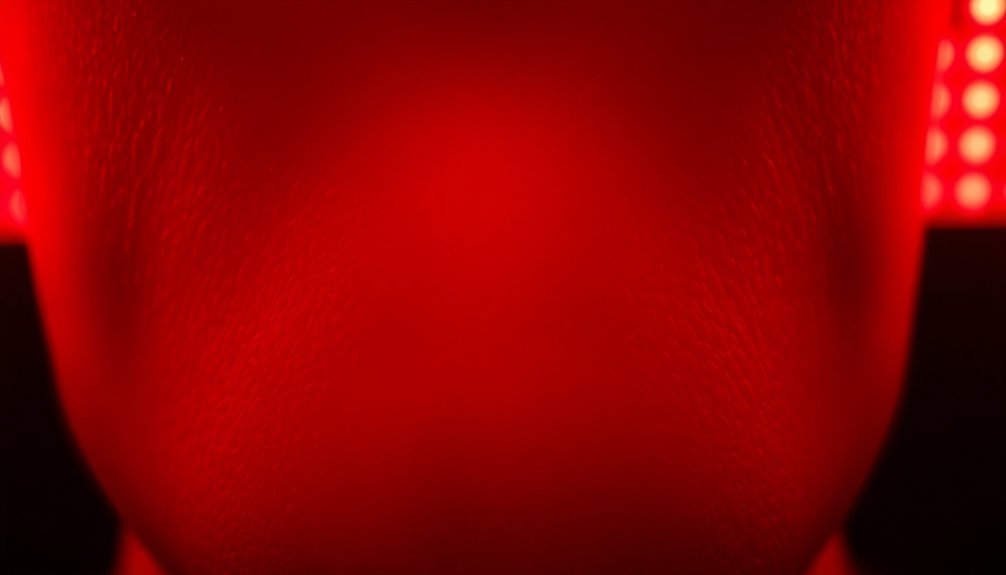
What's particularly interesting is how red light reduces inflammation at the cellular level. It's not just about surface-level effects – you're getting benefits that work from the inside out.
The light waves modulate inflammatory responses, helping to calm irritated skin and reduce redness. This anti-inflammatory action, combined with increased cellular energy production, creates an ideal environment for skin healing and regeneration. The therapy specifically enhances the production of mitochondrial ATP, boosting the skin's natural repair processes.
The process doesn't just mask skin issues; it addresses them at their source through these biological mechanisms.
Understanding Collagen Production
Every aspect of collagen production in your skin relies on a complex network of cellular processes and external factors. Your skin's fibroblasts, specialized cells in the dermis, work tirelessly to produce collagen and elastin. When these cells receive proper stimulation through increased blood flow and mitochondrial activity, they boost their collagen-producing capabilities. Collagen remodeling continues up to one year after initial treatments, allowing for ongoing skin improvement.
You'll find that several factors can either enhance or inhibit your skin's collagen production. While aging naturally decreases synthesis, external factors like UV damage and smoking can accelerate this decline. Your diet plays a vital role too – high sugar intake leads to glycation, which hardens collagen fibers and reduces skin elasticity.
| Process | Impact | Enhancement Method |
|---|---|---|
| Fibroblast Activity | Direct Collagen Production | Red Light Therapy |
| Blood Flow | Nutrient Delivery | Exercise & Massage |
| Gene Expression | Protein Synthesis | Vitamin C Intake |
| Wound Healing | Collagen Remodeling | Micro-needling |
| Antioxidant Protection | Collagen Preservation | Sunscreen Use |
Your skin's collagen production depends heavily on protecting these processes while providing the right stimulation. That's why treatments like red light therapy have become increasingly popular – they target multiple aspects of collagen synthesis simultaneously.
Cellular Response To Light Therapy
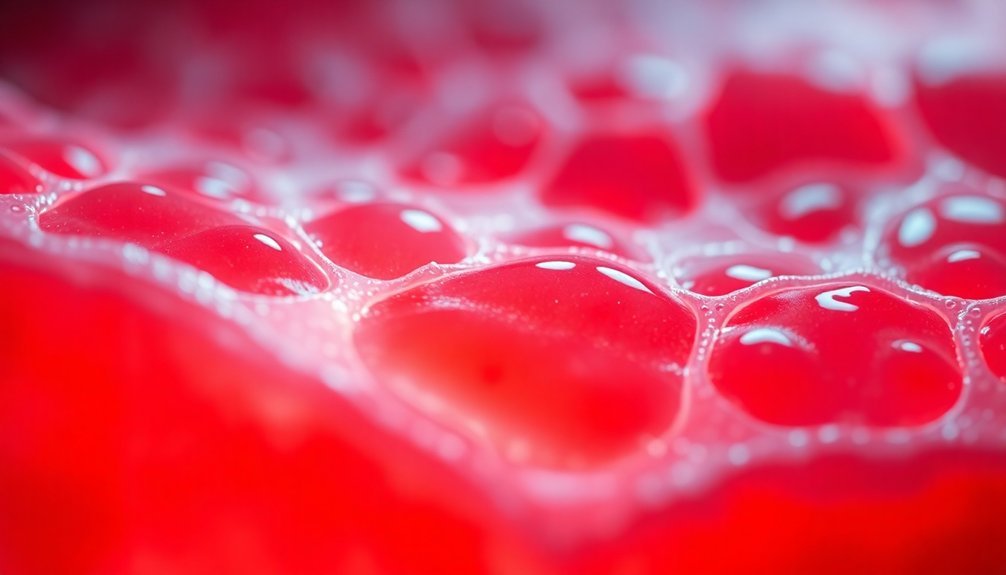
Cellular powerhouses respond dramatically when exposed to red light therapy, triggering a cascade of beneficial reactions in your skin. When red light penetrates your skin, it targets your cells' mitochondria, stimulating them to produce more ATP – your body's primary energy currency. This boost in energy production activates specific genes that control collagen synthesis. The wavelengths used in treatment, ranging from 600 to 1000 nanometers, penetrate deeply into the skin layers for optimal results.
Your cells' response doesn't stop there. The therapy enhances the activity of cytochrome c oxidase, a vital enzyme in your cellular energy production chain. This increased energy powers up your fibroblasts – specialized cells that manufacture collagen – enabling them to work more efficiently.
You'll also notice improved blood flow as the light stimulates the production of vascular growth factors, delivering more oxygen and nutrients to your skin cells.
The cellular response includes a reduction in oxidative stress and inflammation, as your body produces more antioxidant enzymes and anti-inflammatory compounds. Your mitochondria even begin producing new mitochondria, creating a cycle of enhanced energy production.
These combined responses lead to increased collagen density, improved tissue repair, and ultimately, healthier, more youthful-looking skin.
Red Light Wavelength Benefits
Red light's unique wavelengths penetrate deep into your skin's layers, reaching the collagen-producing cells that reside in your dermis.
You'll find the most effective wavelengths fall between 630-670nm for surface benefits and 810-850nm for deeper tissue effects, as these ranges match the peak absorption zones of your skin cells.
These specific wavelengths stimulate your cellular energy production and activate fibroblasts, leading to increased collagen synthesis and improved skin structure. As we age, our natural collagen production declines, making red light therapy an effective solution for maintaining skin health.
Deep Tissue Penetration Benefits
Light therapy's remarkable penetrative power stands at the forefront of modern therapeutic treatments. When you receive red light therapy, the rays penetrate deeply into your body's tissues, reaching muscles, joints, and bones. This deep penetration triggers a cascade of beneficial effects that you can't achieve with surface-level treatments alone.
Your body responds to this deep penetration by increasing blood flow and oxygen delivery to tissues through nitric oxide production. You'll notice enhanced healing as the therapy stimulates ATP production in your deeper tissues, providing energy for cellular repair and regeneration.
If you're dealing with chronic pain or sports injuries, you'll find relief as the therapy effectively targets inflammation at its source.
The penetrative power of red light therapy also boosts your collagen production substantially. As the light reaches your skin's deeper layers, it activates fibroblasts – the cells responsible for producing collagen and elastin. You'll experience improved skin structure and elasticity as these proteins increase.
The therapy's ability to reach deep tissue layers also helps cleanse your cells and extracellular matrix, allowing for more efficient cellular function and continued collagen synthesis.
Peak Wavelength Absorption Zones
Understanding ideal wavelength absorption zones reveals the full potential of your body's cellular response to red light therapy. Your skin cells respond most effectively to specific wavelengths between 630-700 nm, with particularly strong reactions at 660 nm for collagen production. These wavelengths penetrate deeply into your tissue, directly impacting your cellular functions.
You'll get maximum benefits when your cells absorb red light in the 660-750 nm range, which triggers increased blood flow and oxygen delivery to your skin cells. At 660 nm specifically, you'll experience enhanced collagen density as your fibroblasts become more active.
Your mitochondria, the powerhouses of your cells, absorb these wavelengths efficiently, boosting ATP production that's essential for collagen synthesis.
When your cells absorb red light in the 630-700 nm range, they'll experience reduced oxidative stress and improved gene expression related to collagen production. This wavelength zone also stimulates your skin's stem cells, promoting tissue repair and regeneration.
The precision of these wavelengths matters because they're specifically tuned to activate your fibroblasts and trigger your body's natural collagen-producing mechanisms.
Natural Anti-Aging Process

Your skin's natural anti-aging process relies on cellular energy production, which you can enhance through targeted red light therapy.
When red light penetrates your skin layers, it kickstarts your cells' power centers to boost collagen production and tissue regeneration.
Your skin then begins to repair itself more efficiently, using this renewed energy to reduce wrinkles and improve texture naturally.
Cell Energy Powers Youth
The natural aging process kicks into high gear when your cells lack the energy they need to repair and regenerate. Red light therapy directly addresses this issue by boosting your cells' ATP production, which serves as their primary energy source.
When your skin cells have abundant ATP, they're better equipped to produce collagen, repair damage, and maintain a youthful appearance.
Think of ATP as your skin's battery pack – when it's fully charged, your cells can effectively carry out their anti-aging functions. Red light therapy helps recharge these cellular batteries, enabling your skin to work at its finest level.
- Your skin cells use ATP to power collagen and elastin production, giving you firmer, more elastic skin
- Increased cellular energy helps fibroblasts work more efficiently, supporting tissue repair
- Enhanced ATP levels boost circulation, delivering more nutrients to your skin cells
- Improved energy production helps cells remove waste products more effectively
When combined with healthy lifestyle choices like regular exercise, proper hydration, and adequate sleep, red light therapy's ATP-boosting effects can substantially enhance your skin's natural anti-aging processes. You'll notice improved skin texture, reduced fine lines, and a more youthful complexion.
Deep Healing Through Light
Deep beneath your skin's surface, red and near-infrared light waves trigger a remarkable natural healing process that revolutionizes anti-aging treatments. When these therapeutic wavelengths penetrate your skin's layers, they stimulate your fibroblast cells to boost collagen and elastin production naturally.
| Light Type | Penetration | Primary Benefits |
|---|---|---|
| Red Light | Mid-depth | Collagen boost, wrinkle reduction |
| Near-infrared | Deep tissue | Enhanced healing, cell repair |
| Combined therapy | Multiple layers | Extensive rejuvenation |
Your skin's cells absorb these light particles through their mitochondria, increasing ATP production and supercharging cellular metabolism. This boost in energy allows your cells to work more efficiently, producing the structural proteins needed for firm, youthful skin. You'll find this process particularly effective because the light waves can reach deeper tissue layers where traditional topical treatments can't penetrate.
Unlike invasive procedures, you won't experience any downtime with light therapy. The treatment works with your body's natural processes, stimulating healing from within. When devices contour closely to your skin's surface, they deliver uniform energy that maximizes absorption and effectiveness, leading to sustained improvements in skin texture and firmness over time.
Skin Repairs Itself Naturally
Naturally resilient, skin possesses an incredible ability to repair and rejuvenate itself through continuous cycles of cell turnover and collagen synthesis. Your skin's natural healing process works around the clock, shedding old cells and generating new ones to maintain its protective barrier.
You'll enhance your skin's natural repair mechanisms through simple lifestyle choices and proper skincare habits. Regular exercise boosts blood circulation, delivering essential nutrients to skin cells, while quality sleep allows for maximum regeneration.
When you maintain proper hydration and protect your skin with SPF 30+, you're supporting these innate healing processes.
- Your skin produces collagen continuously, helping maintain elasticity and firmness
- Natural antioxidants like vitamin C counteract damaging free radicals
- Plant-based ingredients such as green algae extract stimulate skin regeneration
- Ceramides support your skin's barrier repair functions
Your skin's self-repair capabilities work best when you provide the right environment. That means avoiding harmful substances like cigarettes and alcohol while incorporating gentle skincare products.
When you combine these practices with proper nutrition and stress management, you're optimizing your skin's natural healing potential.
Skin Rejuvenation Through Light
Science's latest breakthrough in skin rejuvenation harnesses the power of specific light wavelengths to stimulate natural collagen production. When you expose your skin to red and near-infrared light, particularly wavelengths between 630-670 nm and 810-850 nm, you're triggering a powerful cellular response that boosts collagen synthesis.
Your skin's fibroblast cells respond to red light therapy by increasing their ATP production, which they then use to create more collagen. This process doesn't just enhance collagen density; it also improves your skin's elasticity and firmness.
You'll notice reduced inflammation, improved texture, and fewer fine lines as your skin responds to the treatment.
You can access this technology through professional treatments at a dermatologist's office or with at-home LED devices. While red light specifically targets collagen production, different wavelengths offer various benefits – blue light fights acne, while amber light addresses other skin concerns.
When you combine LED therapy with photosensitive drugs in photodynamic therapy, you'll see even more dramatic results. Whether you're dealing with aging concerns, acne, or scarring, light therapy can help rejuvenate your skin through this scientifically proven process.
Clinical Studies and Results
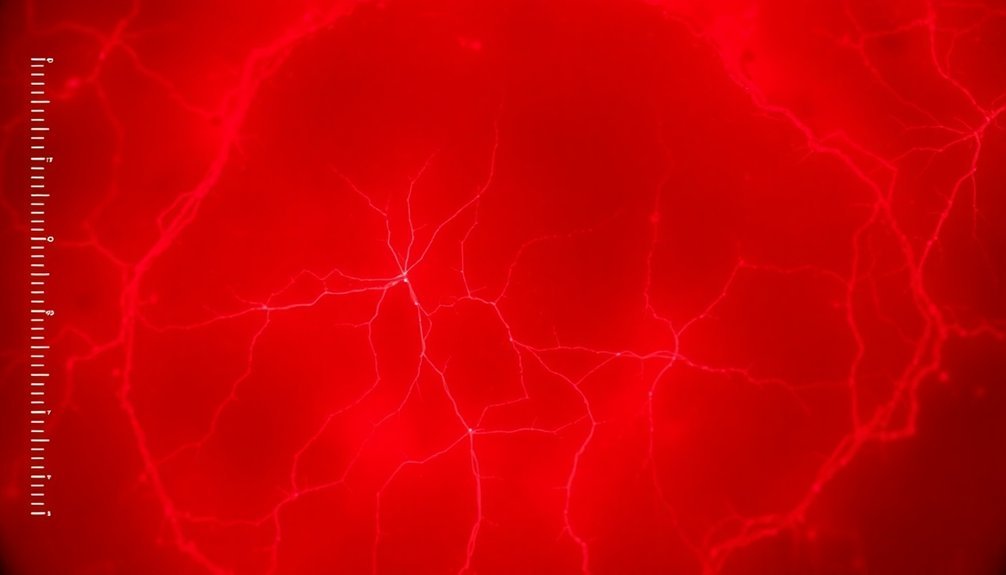
Through extensive clinical research, red light therapy has demonstrated remarkable success rates in skin rejuvenation and collagen production. Studies have shown that patients experience a 100% increase in collagen levels when exposed to red light treatments, while 45% show significant wrinkle reduction.
You'll find that 90% of participants report both reduced pore size and improved skin clarity after completing their treatment cycles.
Clinical data confirms that when red light penetrates your dermis, it triggers a cascade of cellular responses. Your fibroblasts receive an energy boost, leading to increased ATP production and enhanced collagen synthesis.
The combination of red and near-infrared light specifically targets genes responsible for collagen production, while simultaneously reducing MMP-1 levels that break down existing collagen.
- 100% increase in measured collagen levels after treatment
- 90% success rate in pore size reduction and skin clarity improvement
- Significant reduction in sebum production for less oily skin
- Enhanced blood circulation supporting sustained collagen synthesis
These results aren't just superficial – the therapy works at a deep cellular level, stimulating your mitochondria and improving blood flow while reducing oxidative stress.
Your skin's enhanced ability to retain moisture and produce elastin creates lasting improvements in firmness and elasticity.
Treatment Methods and Duration
You'll find several effective ways to apply red light therapy, including handheld devices, light panels, and facial masks that deliver ideal wavelengths for collagen production.
Your treatment sessions should last between 10-20 minutes, whether you're using at-home devices or receiving professional treatments at a med spa.
For the best anti-aging results, you'll want to schedule your sessions 3-5 times per week and maintain consistency over several weeks or months.
Application Types and Tools
Modern red light therapy devices come in various forms to suit different treatment needs and lifestyles. You'll find everything from full-body panels for thorough treatment to portable handheld devices for targeted therapy.
These tools use advanced LED technology that delivers specific wavelengths of red and near-infrared light, proven to stimulate collagen production and enhance skin health.
- Full-body panels with adjustable stands for complete coverage during treatment sessions
- Portable belts and wraps that target specific areas while allowing movement
- Handheld devices perfect for facial treatments and small area targeting
- Multi-wavelength systems offering customizable treatment options
You can easily incorporate these devices into your daily routine, thanks to their user-friendly designs and safety features. Most come with touch screens and adjustable settings, letting you control the intensity and duration of your treatments.
The devices are built to prevent overheating and minimize EMF exposure, making them safe for regular home use. Whether you're targeting wrinkles, improving skin elasticity, or boosting overall skin health, there's a device designed to meet your specific needs.
Their durable construction guarantees reliable performance over time, while their versatile designs accommodate different body types and treatment positions.
Recommended Session Lengths
In accordance with clinical studies, red light therapy sessions typically range from 5 to 30 minutes, depending on your specific needs and treatment goals.
If you're new to red light therapy, start with shorter 5-10 minute sessions and gradually increase the duration as your body adapts to the treatment.
For collagen production and skin rejuvenation, you'll want to schedule 10-15 minute sessions two to three times weekly. If you're dealing with specific skin concerns like scars or wrinkles, maintain this schedule for at least three weeks to see noticeable improvements.
Your age will influence the ideal session length – if you're younger, you can stick to shorter 15-25 minute sessions, while older adults may need 15-30 minutes for enhanced tissue regeneration.
Don't assume longer sessions will yield better results. Sessions exceeding 30 minutes won't provide additional benefits and might even be counterproductive. Instead, focus on consistency and proper spacing between treatments to allow for cellular activity.
If you're using an at-home device, aim for 10-15 minute sessions two to three times per week, while clinical settings might recommend 15-30 minute sessions for specific conditions.
Treatment Frequency Guidelines
Building on proper session lengths, establishing the right treatment frequency is key for maximizing collagen production benefits.
For ideal collagen stimulation, you'll need to commit to 3-4 weekly sessions during the first few months, then maintain with 1-2 sessions per week. If you're doing multiple sessions in one day, keep them at least 6 hours apart to allow your skin to respond properly.
- Start with 3 times per week minimum, but aim for daily treatments when possible
- Space multiple daily sessions at least 6 hours apart
- Deliver 3-15 joules of red light (660nm) per treatment for skin benefits
- Schedule 5-7 sessions weekly for consistent collagen production
Your treatment frequency may need adjustment based on your skin type, condition severity, and the device you're using. Higher-intensity devices require shorter, less frequent sessions, while lower-intensity ones need longer, more consistent treatments.
While following these guidelines, always monitor your skin's response and adjust accordingly. If you experience any irritation or unusual reactions, reduce your treatment frequency and consult a healthcare provider.
Remember to follow your device manufacturer's specific instructions to prevent overexposure and maintain safe, effective treatments.
Combining Treatments for Best Results
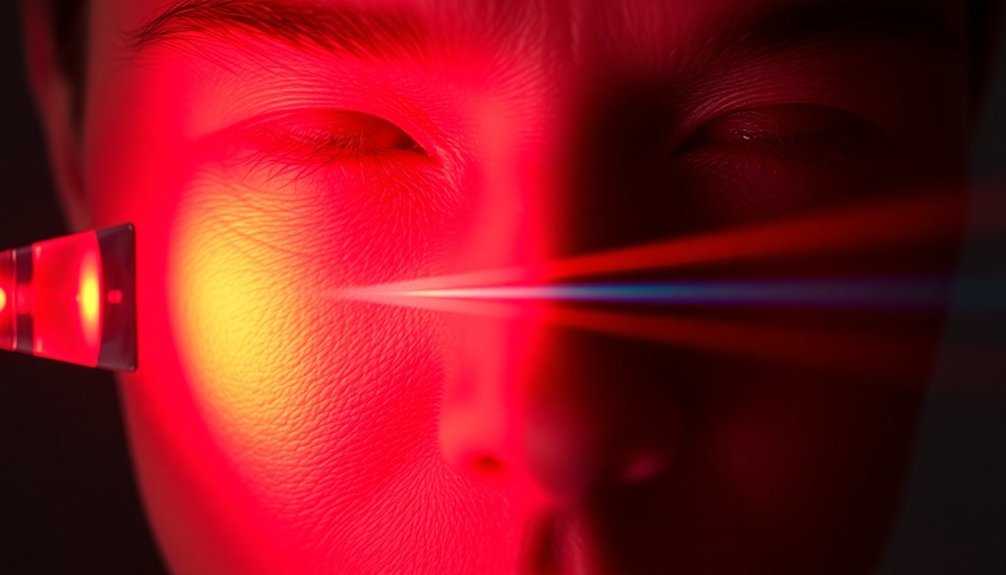
Successful collagen enhancement often requires a strategic combination of treatments alongside red light therapy. You'll find that pairing red light sessions with treatments like microdermabrasion or chemical peels can substantially boost your skin's collagen production and overall health.
When you're planning your skincare routine, consider combining these treatments for maximum effectiveness:
| Treatment Type | Benefits with Red Light |
|---|---|
| Microdermabrasion | Enhanced skin rejuvenation |
| Chemical Peels | Increased collagen synthesis |
| Blue Light | Better acne control |
| Skincare Products | Improved product absorption |
| Near-infrared Light | Deeper tissue penetration |
For ideal results, you'll want to schedule 10-20 minute sessions several times per week. If you're using professional treatments, your sessions might be shorter but more intense. The key is consistency – you'll need regular treatments over several weeks or months to see noticeable improvements in skin texture and elasticity.
Remember to use devices that emit wavelengths between 630nm and 850nm, as these frequencies are most effective for stimulating collagen production. Whether you choose at-home devices or professional treatments, make sure they're FDA-approved for safety and efficacy.
Safe Usage and Precautions
Safety always comes first when using red light therapy, despite its generally favorable safety profile. While FDA clearance indicates basic safety standards, it's vital to understand that this doesn't guarantee effectiveness.
If you're considering red light therapy, consulting with a dermatologist is important, especially if you have darker skin or photosensitive conditions.
- Always wear protective goggles to prevent potential eye damage
- Follow device instructions precisely to avoid skin irritation or blistering
- Check if your medications might increase light sensitivity
- Use only FDA-cleared devices designed for your specific skin concern
You'll need to be particularly cautious if you have certain conditions like lupus or photosensitivity, as red light therapy could worsen these conditions.
If you experience any unusual reactions, such as excessive redness or blistering, discontinue use immediately.
Remember that at-home devices mightn't match the effectiveness of professional equipment, and their long-term effects aren't fully understood yet.
While temporary mild pain or skin irritation is common, anything beyond that warrants medical attention.
For the safest experience, start with shorter sessions and gradually increase the duration as your skin adjusts.
Professional Versus Home Treatments
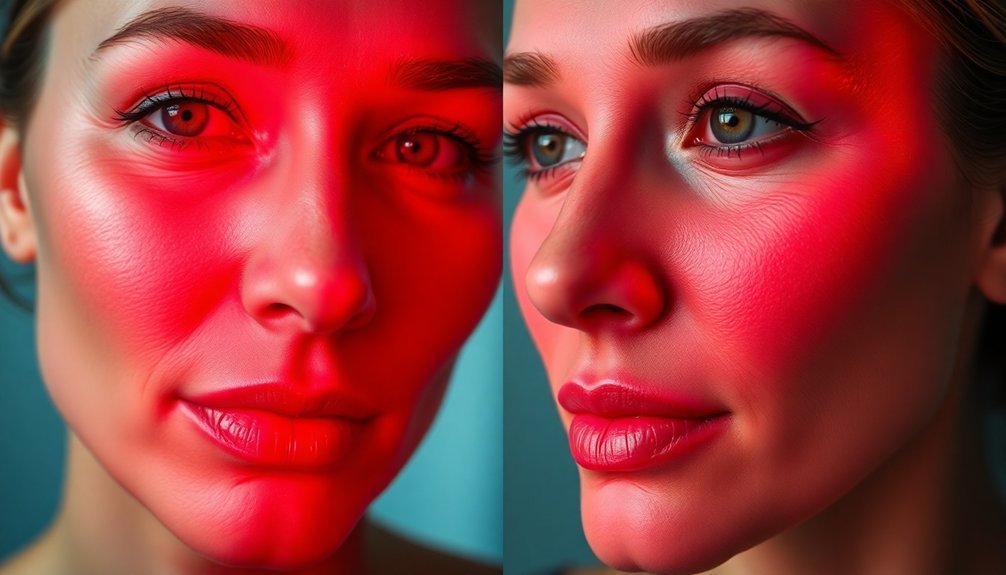
When deciding between professional and home treatments for red light therapy, you'll find distinct advantages for each option.
Professional treatments offer clinically proven results with twice-weekly sessions that stimulate fibroblast growth factors and increase collagen synthesis. These treatments can be precisely tailored to your specific skin concerns and are particularly effective for more severe conditions.
Home treatments, while offering standardized protocols, provide unmatched convenience and accessibility. You can use FDA-cleared devices like the Celluma SERIES or DRx SpectraLite FaceWare Pro regularly, which has shown to build collagen effectively in as little as one month.
You'll also save money in the long run, as home devices can be used repeatedly after the initial investment.
Both options deliver significant improvements in collagen production and skin health, though they differ in approach. If you're dealing with mild skin concerns, a home device might be your best choice. However, if you're targeting more serious skin issues, you might want to opt for professional treatments or consider combining both approaches for enhanced results.
The key is maintaining consistency with whichever option you choose.
Long-Term Skin Benefits
Regular red light therapy sessions yield remarkable long-term benefits for your skin's health and appearance. When you commit to consistent treatments, you'll notice significant improvements in collagen production, skin elasticity, and overall skin rejuvenation.
Clinical trials have shown up to 19% improvement in skin elasticity, along with visible reductions in wrinkles and fine lines.
The therapy's anti-aging effects stem from its ability to activate cellular repair mechanisms and promote tissue healing. You'll experience continued enhancement in skin health through increased collagen density and reduced inflammation, with benefits that persist long after your treatments.
Key long-term benefits you'll gain:
- Enhanced collagen production through fibroblast activation and increased ATP levels
- Reduced appearance of wrinkles, fine lines, and cellulite
- Improved skin texture and decreased visibility of scar tissue
- Sustained reduction in skin inflammation and enhanced tissue healing
The most impressive aspect is that these benefits don't fade quickly. With regular treatments, your skin maintains its improved elasticity and collagen production levels, while continuing to benefit from reduced inflammation and enhanced cellular repair processes.
Frequently Asked Questions
Can Red Light Therapy Fade or Remove Existing Tattoos?
No, red light therapy won't fade or remove your existing tattoos. While it's safe to use on tattooed skin and can help with healing, it doesn't penetrate deeply enough to affect the ink layers.
Does Taking Collagen Supplements Enhance the Effects of Red Light Therapy?
Taking collagen supplements won't enhance red light therapy's effects. They work through different mechanisms – supplements provide external collagen, while red light therapy stimulates your body's natural collagen production independently.
Will Red Light Therapy Work Differently on People With Darker Skin?
While you'll still get benefits from red light therapy with darker skin, your higher melanin levels may affect light absorption. You might need more sessions, but it's still effective for skin rejuvenation and repair.
Can Red Light Therapy Be Used During Pregnancy or While Breastfeeding?
You can safely use red light therapy during pregnancy and breastfeeding. It's non-invasive and shows no adverse effects. Studies suggest it may even reduce your risk of late-onset preeclampsia during pregnancy.
Does Wearing Sunscreen Affect the Effectiveness of Red Light Therapy Treatments?
You don't need to worry about sunscreen affecting your red light therapy. It won't interfere with the treatment's effectiveness since sunscreen blocks UV rays, not the specific wavelengths used in red light therapy.
In Summary
Red light therapy's proven benefits for your skin's collagen production make it a valuable addition to your anti-aging routine. You'll see the best results when you combine professional treatments with at-home devices and maintain consistent sessions. Remember to follow safety guidelines, and you'll enjoy firmer, more youthful skin through this natural, non-invasive approach to skin rejuvenation. Don't forget to consult a skincare professional before starting treatment.
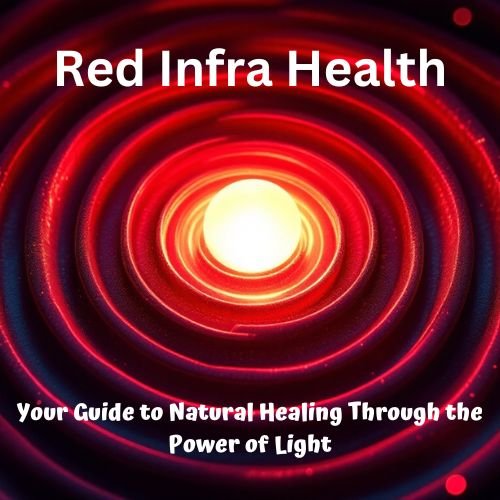
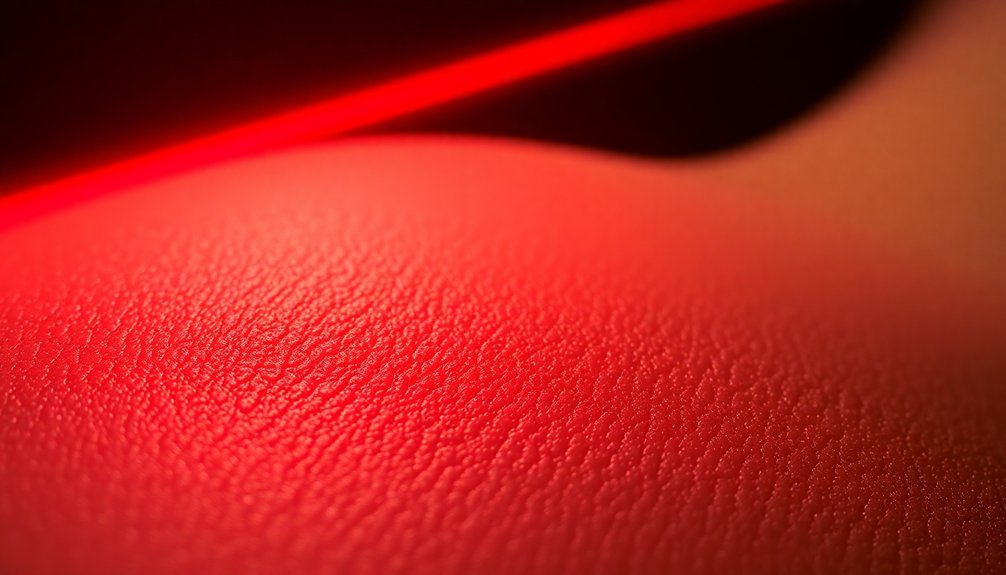

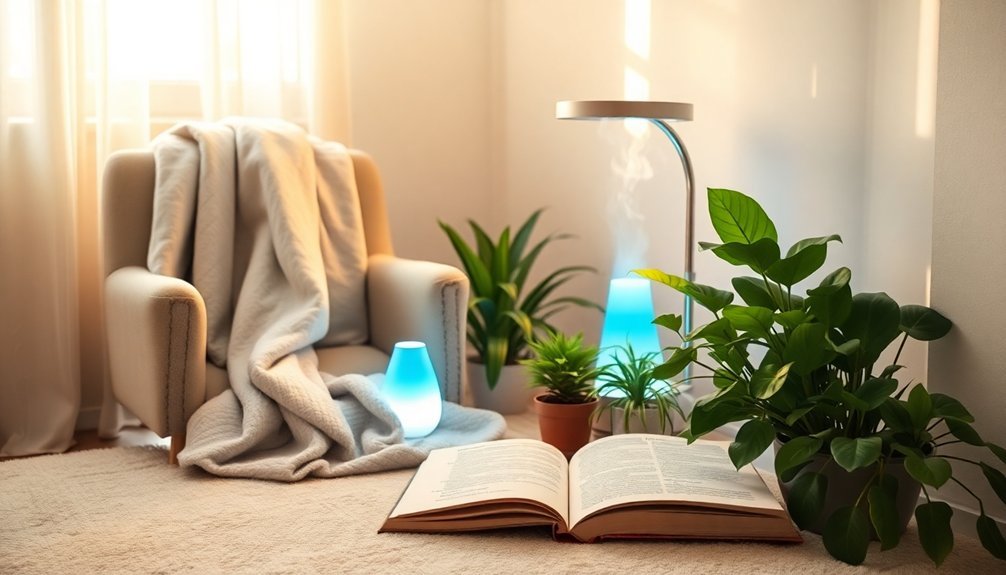
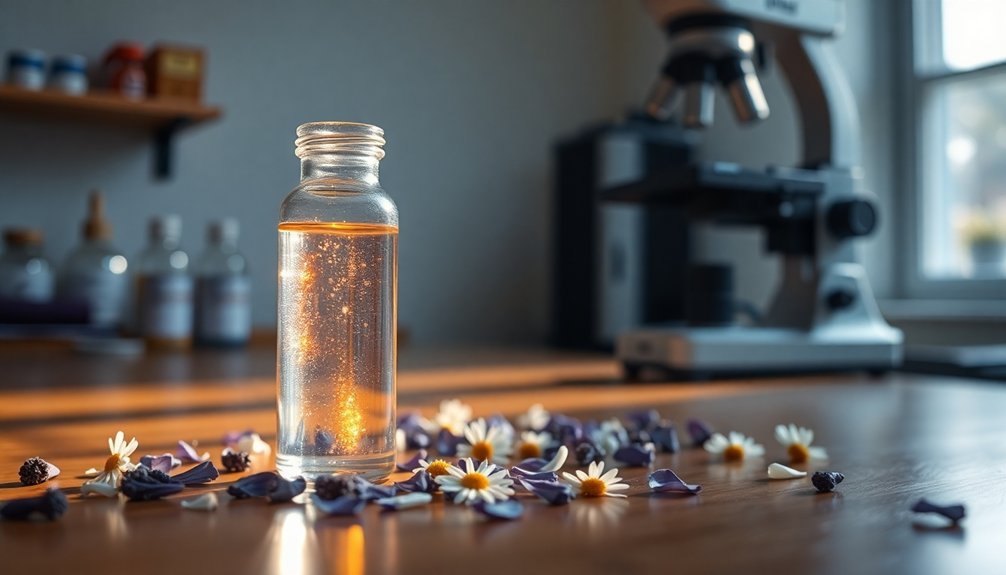
Leave a Reply